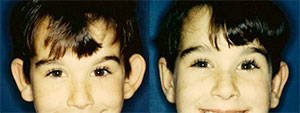In part one of our two-part blog series, Dr. Craig Rowin explained how ear surgery can help improve the lives of both children and adults. In this follow up discussion, he will provide an overview of the challenges of working with the ear and some of the techniques he employs to optimize results.
Even though ears are anatomically fairly simple and composed of only cartilage and skin, there is no external visible structure on the human body more complex than the ear. Not all prominent ears are the same – there are many different types – and depending on our findings, the otoplasty technique used for correction will vary. In general, the surgical scar is hidden behind the ear, though sometimes the procedure may necessitate a small incision under the rim of the ear on the front side to help achieve a more normal curvature and cartilage contour. In nearly all cases, corrective surgery for the ears is performed as an outpatient procedure and recovery is fairly easy and rapid.
Due to the ear’s unique curvatures and structure, there are many variants of what is considered a “normal” looking ear, and few people other than plastic surgeons are experts on the ear’s complex anatomy. With the exception of hats or scarves in the winter, most of us have our ears, nose, and face exposed at all times – unlike the rest of our bodies. Therefore, it is important for all of us, as individuals interacting with society, to feel positive about our external appearance. In my experience, patients feel more sensitive about the appearance of their ears than any other part of the face, perhaps with the possible exception of the nose. Fortunately, the correction of prominent ears is a fairly straightforward undertaking with potentially huge benefits for the patient.
To learn more about Dr. Craig Rowin and Plastic Surgery of the Carolinas, please contact our office today.
